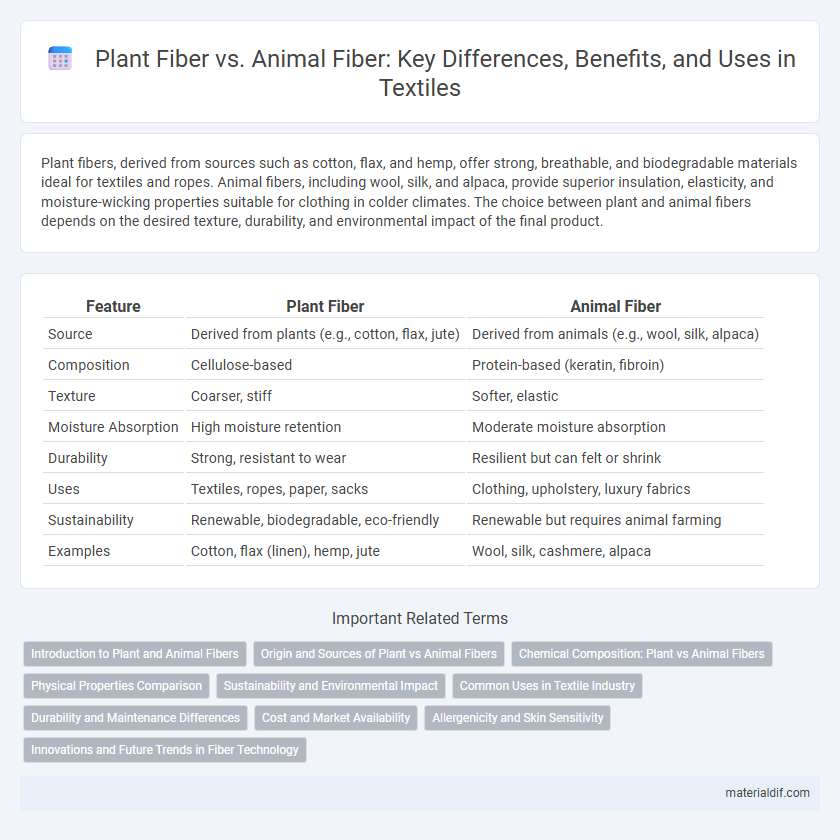Plant fibers, derived from sources such as cotton, flax, and hemp, offer strong, breathable, and biodegradable materials ideal for textiles and ropes. Animal fibers, including wool, silk, and alpaca, provide superior insulation, elasticity, and moisture-wicking properties suitable for clothing in colder climates. The choice between plant and animal fibers depends on the desired texture, durability, and environmental impact of the final product.
Table of Comparison
| Feature | Plant Fiber | Animal Fiber |
|---|---|---|
| Source | Derived from plants (e.g., cotton, flax, jute) | Derived from animals (e.g., wool, silk, alpaca) |
| Composition | Cellulose-based | Protein-based (keratin, fibroin) |
| Texture | Coarser, stiff | Softer, elastic |
| Moisture Absorption | High moisture retention | Moderate moisture absorption |
| Durability | Strong, resistant to wear | Resilient but can felt or shrink |
| Uses | Textiles, ropes, paper, sacks | Clothing, upholstery, luxury fabrics |
| Sustainability | Renewable, biodegradable, eco-friendly | Renewable but requires animal farming |
| Examples | Cotton, flax (linen), hemp, jute | Wool, silk, cashmere, alpaca |
Introduction to Plant and Animal Fibers
Plant fibers, derived from cellulose-rich sources such as cotton, flax, and hemp, offer natural breathability and biodegradability, making them ideal for eco-friendly textiles. Animal fibers, including wool, silk, and alpaca, consist primarily of proteins like keratin, providing superior insulation and elasticity for high-performance clothing. Understanding the distinct cellular structures and chemical compositions of these fibers is essential for optimizing their use in textile manufacturing and sustainable fashion.
Origin and Sources of Plant vs Animal Fibers
Plant fibers originate from cellulose-rich parts of plants such as stems, leaves, and seeds, with common sources including cotton, flax, hemp, and jute. Animal fibers derive from protein-based sources like hair, fleece, and secretions of mammals and insects, examples being wool, silk, alpaca, and mohair. The fundamental difference lies in plant fibers being cellulose-based and sourced from botanical materials, while animal fibers are protein-based and harvested from animal fibers and secretions.
Chemical Composition: Plant vs Animal Fibers
Plant fibers primarily consist of cellulose, hemicellulose, and lignin, which provide structural rigidity and resistance to microbial degradation. Animal fibers are mainly composed of proteins such as keratin in wool and silk fibroin in silk, featuring amino acid chains with sulfur-containing cysteine that contribute to elasticity and strength. The chemical composition differences influence properties like moisture absorption, durability, and texture between plant and animal fibers.
Physical Properties Comparison
Plant fibers such as cotton, flax, and hemp exhibit high tensile strength, low elasticity, and excellent moisture absorption due to their cellulose composition, making them breathable and durable for textiles. Animal fibers like wool, silk, and alpaca contain protein-based keratin, offering superior elasticity, warmth retention, and natural resilience, with unique crimp structures providing insulation and flexibility. The physical differences in fiber diameter, surface texture, and tensile behavior directly influence the choice of fiber for specific applications in apparel and industrial uses.
Sustainability and Environmental Impact
Plant fibers such as cotton, hemp, and flax are renewable, biodegradable, and generally require fewer greenhouse gas emissions compared to animal fibers like wool, silk, or alpaca, which involve higher resource consumption due to animal husbandry. The cultivation of plant fibers promotes soil health and carbon sequestration when managed sustainably, whereas animal fiber production contributes to methane emissions and land degradation. Selecting plant-based fibers significantly reduces water usage and chemical inputs, making them more environmentally friendly and sustainable choices for textile manufacturing.
Common Uses in Textile Industry
Plant fibers like cotton, flax, and hemp are widely used in the textile industry for producing breathable, durable fabrics ideal for clothing, home textiles, and upholstery. Animal fibers such as wool, silk, and alpaca offer superior warmth, elasticity, and softness, making them preferred materials for high-quality garments, knitwear, and luxury textiles. The choice between plant and animal fibers depends on the desired fabric properties, with plant fibers favored for ventilation and moisture absorption, while animal fibers excel in insulation and texture.
Durability and Maintenance Differences
Plant fibers such as cotton, flax, and hemp exhibit high durability due to their cellulose structure, making them resistant to wear and frequently easier to maintain with simple washing techniques. Animal fibers like wool and silk possess protein-based structures that provide elasticity and warmth but often require delicate care to prevent shrinkage and damage, including gentle hand washing or dry cleaning. The inherent durability of plant fibers suits heavy-duty applications, while animal fibers demand specific maintenance to preserve their softness and longevity.
Cost and Market Availability
Plant fibers, such as cotton and flax, generally offer lower production costs and wider market availability compared to animal fibers. Animal fibers like wool and silk are often priced higher due to labor-intensive harvesting and limited supply. Market demand for plant fibers remains strong in textile manufacturing due to affordability and sustainable sourcing.
Allergenicity and Skin Sensitivity
Plant fibers such as cotton and linen generally offer lower allergenicity and are less likely to irritate sensitive skin compared to animal fibers like wool and silk, which contain proteins that can trigger allergic reactions. Plant fibers are hypoallergenic due to their natural cellulose composition, making them ideal for individuals with eczema or dermatitis. Animal fibers often carry lanolin and other allergens, increasing the risk of skin sensitivity and allergic responses in prone individuals.
Innovations and Future Trends in Fiber Technology
Innovations in plant fiber technology emphasize enhancing tensile strength and biodegradability through nano-cellulose extraction and genetically modified crops, positioning plant fibers as sustainable alternatives to synthetic materials. Animal fiber advancements focus on bioengineering wool and silk proteins to improve elasticity, moisture-wicking capabilities, and antimicrobial properties, expanding their application in smart textiles. Future trends foresee hybrid fibers combining plant and animal sources with nanotechnology for eco-friendly, high-performance fabrics tailored to dynamic consumer demands and environmental regulations.
Plant Fiber vs Animal Fiber Infographic

 materialdif.com
materialdif.com